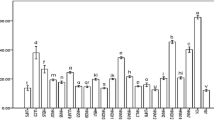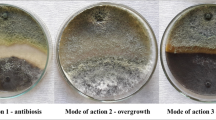Abstract
The soil fungus Polymyxa betae, Keskin, besides being a root parasite, plays a role of a vector in dissemination of Beet necrotic yellow vein virus (BNYVV) causing rhizomania in sugar beet. An alternative to its chemical control is the application of antagonistic microorganisms suppressing proliferation of the fungal vector. In the present work, 66 Trichoderma isolates have been obtained from sugar beet plantations from diverse locations in Slovakia. The ability of the selected isolates to grow at low temperature (10 °C) and to suppress the colonization of roots with P. betae and the multiplication of BNYVV in roots under glasshouse conditions were tested. The roots of sugar beet seedlings growing in the BNYVV-infested soil were analyzed by serological ELISA test using monoclonal and polyclonal antibodies for the presence of BNYVV and checked microscopically for the occurrence of cystosori of P. betae. The efficacy of the selected strains to suppress the proliferation of BNYVV varied on the average between 21 and 68%. On the basis of these tests, candidate strains for practical application in biocontrol of sugar beet rhizomania were selected.
Similar content being viewed by others
References
Abd-el Moity T.H. & Shatla M.N. 1981. Biological control of white rot disease of onion (Sclerotium cepivorum) by Trichoderma harzianum. Phytopathol. Z. 100: 2–35.
Abe, H. & Tamada, T. 1986. Association of beet necrotic yellow vein virus with isolates of Polymyxa betae Keskin. Ann. Phytopathol. Soc. Jpn. 52: 235–247.
Antal, Z., Manczinger, L., Szakacs, L., Tengerdi, R.P. & Ferenczy, L. 2000. Colony growth, in vitro antagonism and secretion of extracellular enzymes in cold-tolerant strains of Trichoderma species. Mycol. Res. 104: 545–549.
Asher, M.J.C. 1993. Rhizomania, pp. 311–346. In: Cooke, D.A. & Scott, R.K. (eds), The sugar beet crop: science into practice. Chapman and Hall, London.
Bakshi, S., Sztejnberg, A. & Yarden O. 2001. Isolation and characterization of cold-tolerant strain of Fusarium proliferatum, a biocontrol agent of grape downy mildew. Phytopathol. 91: 1062–1068.
Blant, S.J., Asher, M.J.C. & Gilligan, C.A. 1991. Infection of sugar beet with Polymyxa betae in relation to soil temperature. Plant Pathol. 40: 257–267.
Campbell, R.N. 1996. Fungal transmission of plant viruses. Annu. Rev. Phytopathol. 34: 87–108.
Camporota, P., Bordei, V. & Richard-Mollard, M. 1988. Lutte biologique contre Polymyxa betae (Keskin) au moyen de Trichoderma sp. Résultats preliminaires in vivo. Agronomie 8: 223–225.
Chet, I., Harman, G.E. & Baker, R. 1981. Trichoderma hamatum: Its hyphal interactions with Rhizoctonia solani and Pythium spp. Microb. Ecol. 7: 29–38.
Clark, M. F. & Adams, A.N. 1977. Characteristics of the microplate method of enzyme-linked immunosorbent assay for the detection of plant viruses. J. Gen. Virol. 34: 474–483.
D’Ambra, V. & Mutto, S. 1986. Parasitismo di Trichoderma harzianum su cistosori di Polymyxa betae. J. Phytopathol. 115: 61–72.
De Meyer, G., Bigirimana, J., Elad, Y. & Höfte, M. 1998. Induced systemic resistance in Trichoderma harzianum T39 biocontrol of Botrytis cinerea. Eur. J. Plant Pathol. 104: 279–286.
Farkaš, V., Labudová, I., Bauer, Š. & Ferenczy, L. 1981. Preparation of mutants of Trichoderma viride with increased production of cellulase. Folia Microbiol. 26: 129–132.
Fujisawa, I. & Sugimoto, T. 1977. Transmission of beet necrotic yellow vein virus by Polymyxa betae. Ann. Phytopathol. Soc. Jpn. 43: 583–586.
Harman, G.E., Howel, C.R., Viterbo, A., Chet, I. & Lorito, M. 2004. Trichoderma species-opportunistic, avirulent plant symbionts. Nature Rev. Microbiol. 2: 43–56.
Heidel, G.B. & Rush, C.M. 1994. Distribution of beet necrotic yellow vein virus, beet distortion mosaic virus, and an unnamed soilborne sugar beet virus in Texas and New Mexico. Plant Dis. 78: 603–606.
Hjeljord, L. & Tronsmo, A. 1998. Trichoderma and Gliocladium in biological control: an overview, pp. 131–151. In: Harman, G.E., Kubicek, C.P. (eds), Trichoderma and Gliocladium. Enzymes, Biological Control and Commercial Applications. Taylor and Francis, London.
Kastirr, U. & Schmidt, K. 1990. Wirkung von Trichoderma — Stämmen gegen den Befall von Zuckerrübenwurzeln durch Polymyxa betaeKeskin. Arch. Phytopathol. Pflschutz. 26: 507–508.
Koike, N., Hyakumachi, M., Kageyama, K., Tsuyuma, S. & Doke, N. 2001. Induction of systemic resistance in cucumber against several diseases by plant growth-promoting fungi: lignification and superoxide generation. Eur. J. Plant Pathol. 107: 523–533.
Kubicek, C. P., Bisset, J., Druzhinina, I., Kulling-Gradinger, C. & Szakacs, G. 2003. Genetic and metabolic diversity of Trichoderma: a case study on South-East Asian isolates. Fungal Genet. Biol. 38: 310–319.
Papavizas, G.C. 1985. Trichoderma and Gliocladium: biology, ecology, and potential for biocontrol. Annu. Rev. Phytopathol. 23: 23–54.
Paulitz, T.C. & Matta, A. 2000. The role of the host in biological control of diseases, pp. 394–410. In: Albajes, R., Gullino, M.L., Van Lenteren, J.C. & Elad, Y. (eds), Kluwer Academic Publisher. Wageningen, The Netherlands.
Ruppel, E.G., Baker, R., Harman, G.E., Hubbard, J.P., Hecker, R.J.C. & Chet, I. 1983. Field tests of Trichoderma harzianum Rifai agr. as a biocontrol agent of seedling disease in several crops and Rhizoctonia root rot of sugar beet. Crop Prot. 2: 399–408.
Scholten, O.E. & Lange, W. 2000. Breeding for resistance to rhizomania in sugar beet: A review. Euphytica. 112: 219–231.
Sequeira, L. 1983. Mechanisms of induced resistance in plants. Annu. Rev. Microbiol. 37: 51–79.
Smith, V.L., Wilcox, W.F. & Harman, G.E. 1990. Potential for biological control of Phytophthora root and crown rots of apple by Trichoderma and Gliocladium spp., pp. 5. In: Harman, G.E. & Kubicek, C.P. (eds), Trichoderma and Gliocladium. Basic biology, taxonomy and genetics. Taylor and Francis, London.
Stas, A., Meunier, A., Schmidt, J.F., Marlier, A., Steyer, S. & Bragard, C. 2001. The beet soilborne pomovirus in Belgium and relationship with rhizomania. Meded. Rijksuniv. Gent Fak. Landbouwkd. Toegep. Biol. Wet. 66: 39–45.
Šubíková, V., Baumgartnerová, H. & Bojňanský, V. 1992. Occurrence of sugar beet rhizomania disease in Slovakia. Plant Protect. Bull. FAO 40: 46–48.
Tamada, T. 1975. Beet necrotic yellow vein virus. CMI/AAB. Descriptions of Plant Viruses 144: 5.
Thrane, C., Tronsmo, A. & Jensen, D.F. 1997. Endo-β-1-3-glucanase and cellulase from Trichoderma harzianum: purification and partial characterization, induction and biological activity against plant pathogenic Pythium spp. Eur. J. Plant Pathol. 103: 331–344.
Woo, S., Fogliano, V., Scala, F. & Lorito, M. 2002. Synergism between fungal enzymes and bacterial antibiotics may enhance biocontrol. Ant. van Leeuwenhoek 81: 353–356.
Yedidia., Benhamou N. & Chet, I. 1999. Induction of defense responses in cucumber plants (Cucumis sativus L.) by the biocontrol agent Trichoderma harzianum. Appl. Environ. Microbiol. 65: 1061–1070.
Yedidia, I., Shoresh, M., Kerem, Z., Benhamou, N., Kapulnik, Y. & Chet, I. 2003. Concomitant induction of systemic resistance to Pseudomonas syringae pv. lachrymans in cucumber by Trichoderma asperellum (T-203) and accumulation of phytoalexins. Appl. Environm. Microbiol. 69: 7343–7353.
Author information
Authors and Affiliations
Rights and permissions
About this article
Cite this article
Jakubíková, L., Šubíková, V., Nemčovič, M. et al. Selection of natural isolates of Trichoderma spp. for biocontrol of Polymyxa betae as a vector of virus causing rhizomania in sugar beet. Biologia 61, 347–351 (2006). https://doi.org/10.2478/s11756-006-0063-3
Received:
Accepted:
Issue Date:
DOI: https://doi.org/10.2478/s11756-006-0063-3




